Daniel Wysocki, a SUNY Oswego alumnus now a Ph.D. student at Rochester Institute of Technology and part of the team responsible for Nobel Prize-winning work studying gravitational waves, will present "Seeing with Gravity: A New Era in Astronomy" at 4 p.m. Nov. 10 in Room 175 of the Shineman Center. Researchers have learned much about the universe from events producing gravitational waves, such as two black holes interacting as seen in this NASA illustration.
A SUNY Oswego alumnus who is part of the team responsible for Nobel Prize-winning work studying gravitational waves in deep space will speak at his alma mater Friday, Nov. 10.
Daniel Wysocki will present "Seeing with Gravity: A New Era in Astronomy" at 4 p.m. Nov. 10 in Room 175 of the Shineman Center as part of the college's Science Today lecture series.
The 2015 SUNY Oswego physics and computer science graduate is now part of the Rochester Institute of Technology team that is a partner in the Laser Interferometer Gravitational-Wave Observatory, a large-scale physics experiment to detect and learn from gravitational waves. The LIGO/VIRGO program won a 2017 Nobel Prize in physics for research on violent space events "promising a revolution in astrophysics," according to the news release announcing the award that recognized project leaders Rainer Weiss, Barry C. Barish and Kip S. Thorne.
"It's very exciting to be a part of this work," said Wysocki, who is pursuing his doctorate in RIT's School of Physics and Astronomy's astrophysical sciences and technology program. "Many people have spent their entire decades-long careers on this work, with it finally paying off in the past couple years. I'm quite fortunate to have joined when I did, as now's the time when the big discoveries are pouring in."
While the LIGO detectors had to go offline two months ago for a lengthy maintenance process, "when they were running, you never knew what you might wake up to," Wysocki said. On Aug. 17, he remembers waking up "about 20 minutes after we had detected our first neutron star merger, and literally jumping with excitement. I'm looking forward to one year from now, when we restart observations with our highest sensitivity yet."
Astronomical research
Wysocki works specifically "on the astrophysical implications of our gravitational wave detections," he said. "While we've only seen a few black hole mergers, and just recently our first neutron star merger, we know that these objects come from a broader population of objects. The focus of my research is to determine the properties of that population, from simple census questions, to deeper questions about their evolutionary histories."
In his time at Oswego, Wysocki worked with Shashi Kanbur, professor and chair of physics, on research with Cepheid variable stars, trying to calculate the size and age of the universe, and interned at NASA's Jet Propulsion Laboratory.
"I was tasked with finding bugs in a software package which simulates the thermodynamics of Saturn and its rings," he writes of his NASA role on his website. He noted the accuracy of that simulation played a key role in the Cassini Grand Finale, when the space probe did its final analyses after nearly two decades exploring.
"The thing which prepared me most was the research I did with Dr. Shashi Kanbur," Wysocki recalled of his time at SUNY Oswego. "While the subject matter was quite different, it gave me a lot of experience in data analysis, reading scientific literature and presenting my work both to scientists and the general public."
Wysocki is not the only Oswego connection with the Nobel-winning work. Tyson Littenberg, a 2003 SUNY Oswego physics graduate and now a research scientist at the University of Alabama in Huntsville, is among the large international team observing and studying these astrophysical phenomena.
"In this talk, I will go over the history of gravitational wave astronomy, from Einstein's predictions a century ago up until today, and future plans," Wysocki said in his Science Today session description. "I will also discuss the major results to emerge in the past two years, from the properties of the individual observed black holes and neutron stars, to the astrophysical implications."
The Science Today lecture series is presented by Oswego's College of Liberal Arts and Sciences and the college's chapter of scientific research honor society Sigma Xi.
For more information on Wysocki's talk or the Science Today lecture series, call 315-312-6586 or email elizabeth.wilcox@oswego.edu.




